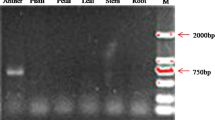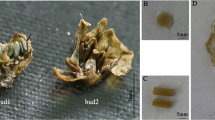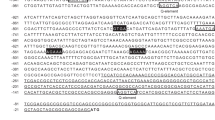Abstract
Cytological and histochemical analyses were performed on developing anthers of wild-type, transgenic male-sterile and fertility-restored Brassica napus plants. Male sterility resulted from the expression of the barnase gene under the control of the tobacco-derived tapetumspecific promoter pTA29. Fertility was restored to male sterile plants by expressing the barstar gene, which encodes a barnase-specific inhibitor protein. In addition, the tissue specificity of the pTA29 promoter in B. napus was studied in transgenic plants expressing pTA29:gus fusions. In B. napus, the pTA29 promoter not only directed the expression of genes to the tapetum, but also, although more weakly, to the vascular tissue region of the anther filament at the late uninucleate and early binucleate stage. The pTA29:barnase gene was expressed in the tapetum at the vacuolated-microspore stage. This resulted in the disappearance of RNA from the tapetum. Degradation of RNA in the tapetum was immediately followed by a complete loss of RNA in the developing microspores. Following lysis of the microspores in the sterile anthers, the pTA29:barnase gene was expressed in the vascular tissue region of the anther filament. This expression resulted in a deposition of wound callose in the phloem, followed by a precocious wilting of the whole anther. Finally, in the fertility-restored plants the cytological and histochemical patterns of anther development were identical to those of wild-type anthers.
Similar content being viewed by others
Abbreviations
- NMS:
-
nuclear male sterility
- WT:
-
wild type
References
Bronner, R., Westphal, E., Dreger, F. (1991) Enhanced peroxidase activity associated with the hypersensitive response of Solanum dulcamara to the gall mite Aceria cladophthirus (Acari:Eriophyoidea). Can. J. Bot. 69, 2192–2196
De Block, M., Debrouwer, D. (1992) In-situ enzyme histochemistry on plastic-embedded plant material. The development of an artefact-free β-glucuronidase assay. Plant J. 2, 261–266
De Block, M., Debrouwer, D., Tenning, P. (1989) Transformation of Brassica napus and Brassica oleracea using Agrobacterium tumefaciens and the expression of the bar and neo genes in the transgenic plants. Plant. Physiol. 91, 694–701
Currier, H.B. (1957) Callose substance in plant cells. Am. J. Bot. 44, 478–488
Edreva, A.M. (1991) Stress proteins of plants: PR(b)-proteins. Sov. Plant Physiol. 38, 579–588
Eschrich, W., Currier, H.B. (1964) Identification of callose by its diachrome and fluorochrome reactions. Stain Technol. 39, 303–307
Evert, R.F., Derr, W.F. (1964) Callose substance in sieve elements. Am. J. Bot. 51, 552–559
Frankel, R., Galun, E. (1977) Pollination mechanisms, reproduction and plant breeding (Monographs on theoretical and applied genetics, vol. 2). Springer, New York
Grant, I., Beversdorf, W.D, Peterson, R.L. (1986) A comparative light and electron microscopic study of microspore and tapetal development in male fertile and cytoplasmic male sterile oilseed rape (Brassica napus). Can. J. Bot. 64, 1055–1068
Hartley, R.W. (1989) Barnase and barstar: two small proteins to fold and fit together. Trends Biochem. Sci. 14, 450–454
Jefferson, R.A. (1987) Assaying chimeric genes in plants: the GUS gene fusion system. Plant Mol. Biol. Rep. 5, 387–405
Jefferson, R.A., Burgess, S.M., Hirsh, D. (1986) β-Glucuronidase from Escherichia coli as a gene-fusion marker. Proc. Natl. Acad. Sci. USA 83, 8447–8451
Kaul, M.L.K. (1988) Male sterility in higher plants (Monographs on theoretical and applied genetics, vol. 10). Springer, Berlin Heidelberg New York
Koltunow, A.M., Truettner, J., Cox, K.H., Wallroth, M., Goldberg, R.B. (1990) Different temporal and spatial gene expression patterns occur during anther development. Plant Cell 2, 1201–1224
Mariani, C., De Beuckeleer, M., Truettner, J., Leemans, J., Goldberg, R.B. (1990) Induction of male sterility in plants by a chimaeric ribonuclease gene. Nature 347, 737–741
Mariani, C., Gossele, V., De Beuckeleer, M., De Block, M., Goldberg, R.B., De Greef, W., Leemans, J. (1992) A chimeric RNase inhibitor gene restores fertility to male sterile plants. Nature 357, 384–387
Nave, E.B., Sawhney, V.K. (1986) Enzymatic changes in postmeiotic anther development in Petunia hybrida. I. Anther ontogeny and isozyme analyses. J. Plant Physiol. 125, 451–465
Sawhney, V.K., Nave, E.B. (1986) Enzymatic changes in postmeiotic anther development in Petunia hybrida. II. Histochemical localization of esterase, peroxidase, malate- and alcohol dehydrogenase. J. Plant Physiol. 125, 467–473
Smith, L.J., Scarisbrick, D.H. (1990) Reproductive development in oilseed rape (Brassica napus cv. Bienvenu). Ann. Bot. 65, 205–212
Theis, R., Röbbelen, G. (1990) Anther and microspore development in different male sterile lines of oilseed rape (Brassica napus). Angew. Botanik 64, 419–434
Van Loon, L.C. (1976) Systemic acquired resistance, peroxidase activity and lesion size in tobacco reacting hypersensitively to tobacco mosaic virus. Physiol. Plant Pathol. 8, 231–237
Vidhyasekaran, P., ed. (1988) Physiology of disease resistance in plants, vol. 2. CRC Press, Boca Raton, Florida
Author information
Authors and Affiliations
Additional information
We thank Dr. E. Krebbers (Plant Genetic Systems, Gent, Belgium) for the critical reading of the manuscript.
Rights and permissions
About this article
Cite this article
De Block, M., Debrouwer, D. Engineered fertility control in transgenic Brassica napus L.: Histochemical analysis of anther development. Planta 189, 218–225 (1993). https://doi.org/10.1007/BF00195080
Accepted:
Issue Date:
DOI: https://doi.org/10.1007/BF00195080




